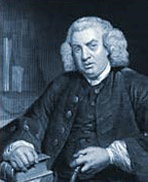Clan Johnstone People
Dr Samuel Johnson (1709-84)
Dr Johnson was a bookseller’s son and received his education from his family until entering Oxford in 1727.
He worked as a journalist for a time and in 1747 obtained an advance for his idea of a dictionary. With six assistants, of whom five were Scottish, his dictionary was published in 1755 and it is not hard to imagine the incredible reception it received. He was editor of The Rambler from 1750-62, during which time he published “Rasselas”, another successful work.
In May 1763, James Boswell introduced himself to Johnson. Ten years later they toured the Western Isles together, recording their experiences for a biography which was published in 1775, called “A Journey To the Western Islands of Scotland”.
The work remains popular among historians, sociologists and anyone wishing to be entertained by Johnson’s sharp opinions and behaviour.
James Johnson (c1753-1811)
The Scots Musical Museum was the creation of James Johnson. He collected Scottish songs and published them in six volumes between 1783 and 1803.
Robert Burns was editor of the collection before his death in 1796, and himself contributed some two hundred songs. The collection, with musical notes added to the figured basses later by Stenhouse and Sharp, is held as one of Scottish history’s most important.
Sir Reginald Fleming Johnston (1874-1938)
Educated at Edinburgh University and Magdalen College, Oxford, Johnston became a Hong Kong Cadet in 1898 and rose to the position of Commissioner of Weihaiwei, Shandong Province from 1927-30. Between 1919-25 the Edinburgh man was tutor to China’s last Emperor.
He travelled to many reaches of the country, was influenced by its Buddhism and is the only European to become a mandarin of the first rank. Johnston wrote “Buddhist China”, published in 1913 and, in 1926, “Twilight in the Forbidden City”.
William Johnstone (1897-1981)
From Denholm in Roxburghshire, Johnstone learned to paint at Edinburgh College of Art between 1919-23. He was not impressed with what the College had to offer and it was in 1925, with a scholarship, he went to Paris and became involved in Surrealism. His work during the 1930s was among Britain’s most original.
He worked as a teacher to earn a living and as Principal of Camberwell School of Arts and Crafts, followed by the same position at the Central School, London, he established the founding principles for teaching modern art.
He retired in 1960 to become a farmer in the Borders, still painting.
Quick Links to Clan Johnstone Products from The Clan Shop
- Johnstone Tartan Tie
- Johnstone Tartan Pocket Square Handkerchief
- Johnstone Tartan Scarves
- Johnstone Tartan Kilts
- Johnstone Clan Crest Badge
- Johnstone Clan Crest Mug
- Johnstone Clan Crest T-Shirts
- Johnstone Clan Crest Belt Buckle
- Johnstone Phone Covers
- Johnstone Tartan
- Johnstone Clan Crest Crystal Glasses
- Johnstone Clan Crest Cufflinks
- Johnstone Clan Crest Sgain Dubh
- Johnstone Clan Crest Kilt Pin
- Johnstone Clan Crest Plaques






